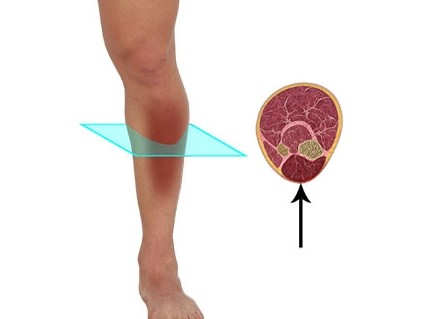Most people with compartment syndrome always face some challenges in running. Besides the issues of how they could manage the condition, they may worry about the right running shoes to use. But can running shoes help compartment syndrome?
The best running shoes for compartment syndrome help to support the runner’s movement by avoiding the technique of heel striking. Rather, the shoes will guide the foot to hit the ground on the midfoot or forefoot. Additionally, they will provide comfort, flexibility, traction, and cushioning against pains while running.
Keep reading to learn how the right running shoes could help with compartment syndrome. Also, the article covers more explanation of what compartment syndrome is, how to prevent it when running, and more.
Compartment Syndrome – What Is It?
Compartment syndrome is a condition that occurs due to an increase in pressure within and around muscles of the body. Such imposed muscle pressure could lead to several limitations and damage (like ischemia) where it occurred. It could halt the free flow of oxygen, blood, and food nutrients to the body’s nerves, tissues, and muscles. In extreme cases, it could result in death.

Irrespective of the severity of the compartment syndrome, its effects follow the same pattern over the affected region. Usually, the blood flow through the veins has a normal pressure that ensures proper circulation. However, any external circumstance that creates higher pressure on the muscles than within the veins will stop the blood flow.
As a result, there will be no oxygen for that part of the body. Also, more waste products will start to accumulate in the region. Hence, the body will remain in pain with nerve irritation around that body region.
Types of Compartment Syndrome
There are mainly two types of Compartment syndrome, namely;
Acute Compartment Syndrome
Acute compartment syndrome is generally the common type of compartment syndrome. It can develop within a few hours or days of increased pressure on a muscle compartment. If you neglect it, an acute compartment syndrome could lead to permanent muscle damage leaving the patient with disability or paralysis. Moreover, there could be the death of the victim in extreme cases.

Chronic Compartment Syndrome
Chronic compartment results from extensive activities like exercises. The muscle compartment has received more physical pressure higher than its normal venous pressure in this situation. Hence, it’s also known as exertional compartment syndrome.

Causes of Compartment Syndrome
Below are some of the causes of compartment syndrome.
- Bone fractures
- Crushing injuries
- Bruised muscles
- Very tight bandaging
- Blood clotting within vessels of the legs or arms
- Surgery on blood vessels
- Burns
- Exercises with extensive pressure
Symptoms of Compartment Syndrome
Here are some of the symptoms of compartment syndrome
- Persistent and extensive pain that exceeds the expected form on regions of the body with injury.
- Deep ache on the legs or arms.
- Swelling and tightness of the muscles.
- Numbness or needle-like shocking pains on the legs or arms.
- Muscle cramps in affected regions of the body.
- Burning or tingling feeling.
Can You Run With Compartment Syndrome?
A person with a compartment-syndrome condition can still run. However, there could be painful sensations around the affected muscle regions. So, the person could alternate the running with some walking breaks.
Walking breaks between the runs are essential if you must run with compartment syndrome. This is because running will put more pressure on the already swollen muscles. Hence, you’ll be forcing them to overwork during your runs.

However, the walking breaks serve as a calming therapy on your muscles and nerves. It creates a relaxation time by putting off excessive pressure from the muscles and nerves. Also, the walking breaks remove pain in the compartment.
Can Running Shoes Help Compartment Syndrome?
Using good running shoes will provide some prominent support for the legs of a runner with compartment syndrome. The shoes will ensure great comfort as the feet strike the ground. Also, it maintains the right cushioning and flexibility that gives the feet adequate space for airflow and ease for the reflexive striking impact.

So can running shoes help compartment syndrome? It does, but you must select the right running shoes with outstanding qualities to help with the condition.
Here are the benefits of quality running shoes for compartment syndrome.
1. Excellent Traction
The traction of a shoe enables it to grip the ground properly. Running is a more vigorous movement than walking. So running shoes should give a firm grip. Without excellent traction, you will frequently stumble and fall several times with your running shoes.
Moreover, such experience is not good for compartment syndrome. So, you must go for running shoes with excellent traction. It will ensure that the sole of the shoes maintains a firmer grip as you hit your feet on the ground.
2. Flexibility
Flexibility is a great factor that matters with a running shoe, especially with compartment syndrome. A flexible shoe will provide the natural effect of foot expansion without restriction while running. It allows the natural curving of your foot as you define the tempo of your running strides. Also, you can effectively run through different surfaces with flexible shoes that will flex out your toes and heels.
In getting a flexible shoe, both the materials for the sole and body of the shoe play some vital roles. For instance, shoes with rubber outsoles are usually flexible. So, always test and select the proper running shoes that provide the right flexing of toes and heels.
3. Great Cushioning
To effectively manage compartment syndrome, you must avoid adding more pressure around the muscles and nerves of the affected legs. Running and hitting your heels repeatedly on the ground could aggravate the pain of compartment syndrome. So, you must use running shoes with quality cushioning that will absorb pressures and shocks.
A great cushioning effect from your running shoes will provide comfort on your heels and toes. Also, it comes with a plush padding that extends to the collar and balls of the feet. You will receive great relief from bruising and aching pains while using good running shoes for compartment syndrome.
4. Zero Drop
The drop of a shoe measures the height difference between the toes and the heel. Usually, with compartment syndrome, the runner should, as much as possible, avoid striking his heel on the ground. This will aggravate the pain of the condition. So, the best running shoes for compartment syndrome must create a balanced level between the toes and the heel.
Moreover, the great advantage of the zero drop is a reduction in the heel striking technique while running. So, you can check the shoes’ specifications or measure the drop personally. Remember that your heel drop measurement must not be lower than 6mm.
5. Breathability
The breathability of a shoe allows free airflow within the foot. It creates more space for the toes to relax and move freely without constraints. This removes the lack of oxygen and blood circulation within the blood vessels and nerves of the foot.
Subsequently, there’ll be no exerted pressure on the foot. Furthermore, breathable shoes will eliminate much heat and sweating on the feet. Hence, the feet will remain considerably dry and prevent bacteria infections from accumulated sweat.
6. Durability
It will be a loss of your money to buy running shoes that could hardly last for you. Durable shoes not only give you value for your money but also depict your sense of choice. The material for both the sole and upper part of the running shoes will determine their durability. So, always select the ones with high-quality materials.
One of the best materials for the upper part of the shoe that will ensure durability and proper ventilation is mesh fabric. For the sole, you may choose those made from rubber for long-lasting and value for your cash.
How To Prevent Compartment Syndrome When Running?
Below are some of the ways you can prevent compartment syndrome when running.
Change of Running Technique
Most victims of compartment syndrome tend to run by striking their heels on the ground. This method of running puts more pressure on the muscles around your feet and legs. Subsequently, it will aggravate the compartment syndrome more as you will feel more pains and aches.

So you must change your running pattern to strike your midfoot or forefoot on the ground alternately. This eliminates pressure from your heels and cuts downs the symptoms of compartment syndrome. Also, continuous use of this new running technique can proffer a permanent cure to the condition.
Engage in Cross-Training
The use of cross-training is one of the favorable measures to maintain running with compartment syndrome. The popular cross-training that you can engage in for adequate fitness is Aqua Jogging. This is because the technique in Aqua Jogging is very similar to that of the natural process of running.

Through Aqua Jogging, your feet will just float inside the water without hitting the ground. It prevents any possible pain or aches that could result in striking your feet on any surface. Also, it’s a safe practice that puts no pressure on any of your bruised muscles and nerves around the region of the compartment syndrome.
Surgical Treatment
You can only treat or handle some cases of compartment syndrome through surgery. The process, which is generally known as fasciotomy involves the reduction of extended fascia by cutting. This creates more room for the compressed muscles, thereby removing any form of pain and aches.
Final Thoughts
Compartment syndrome creates painful pressure on your muscles and nerves while running. So can running shoes help compartment syndrome? Yes, it does, as we’ve seen above. But you must use the right running shoes to get the relief you seek with the condition.
The shoes will offer support to your feet through their cushioning and flexible ability. Also, they will remove pressure from your feet while striking the midfoot on the ground. So, you must select the right running shoes for compartment syndrome.
